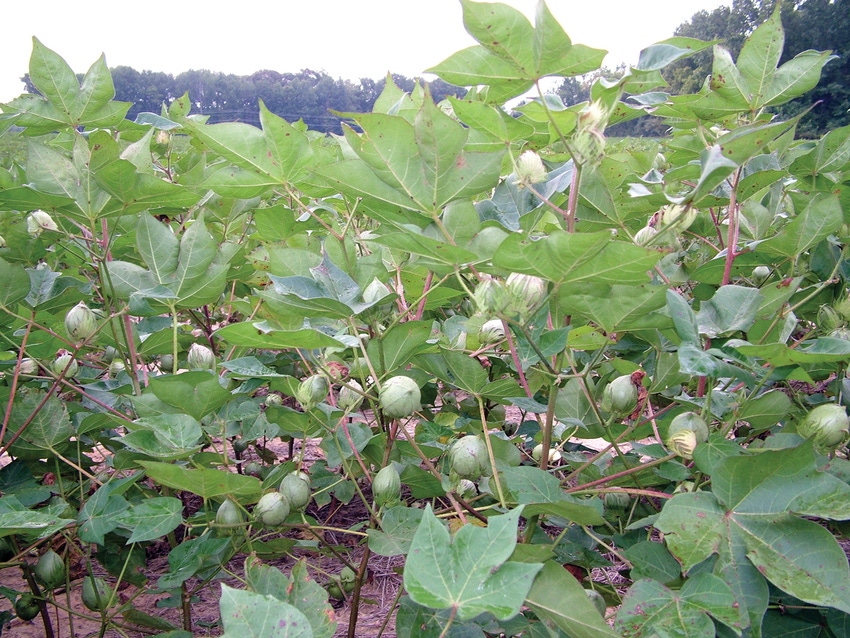August 3, 2012

Despite high heat and long periods without rain, Mississippi’s cotton is looking pretty good, although dealing with reduced acres.
Nationally, producers planted 14 percent less cotton this year than last, primarily because of high corn and soybean prices. Mississippi followed this national trend; producers planted 580,000 acres of cotton in 2012 but 630,000 acres in 2011. About half of the state’s cotton crop is irrigated.
Darrin Dodds, cotton specialist with the Mississippi State University Extension Service, said the smaller crop is about two to three weeks ahead of normal.
“Open bolls are beginning to appear in some of the earliest-planted fields, and some defoliation applications will begin in the second week of August,” he said.
Dodds said the biggest problems the crop faced to date were high temperatures and almost no rain in June. The early-planted crop faced some tremendous pressure from thrips as it began growing, but producers have handled the insect pressure.
“Once the crop was past the stage where thrips are a concern, insect pressure has been relatively light compared to previous years,” Dodds said. “Lately, we are making some insecticide sprays for various other pests.”
Bacterial blight is in the state again this year, and 23 counties have confirmed infections.
Read: As grain prices hit the roof, 2013 cotton acres head for cellar
“We had this issue in 2011 and managed to pick a respectable crop in many instances,” Dodds said. “Time will tell how it will affect the crop this year, but I’m optimistic.”
The U.S. Department of Agriculture estimated the entire cotton crop had squared by the last week of July, and 91 percent was setting bolls. Typically, 85 percent is setting bolls by this time.
Leflore County is traditionally one of the state’s largest cotton-producing counties, but it dropped almost 35 percent of its cotton acreage to just 27,500 acres this year. Cotton there is struggling.
“Our corn and soybeans are looking excellent, but our cotton crop is looking average,” said Jerry Singleton, Extension area agronomy agent in Leflore County. “The rains back in July were a blessing, but we had a lot of cloudy days. Cotton just doesn’t do well when you have several consecutive cloudy days.”
Specifically, cotton sheds its bolls when there are too many cloudy days in a row. Singleton said he heard estimates in one area of projected yields dropping from three bales an acre to one bale an acre.
“There is no way to accurately predict on Aug. 1 what harvest and yields will be like,” he said.
Stone County is not known for its cotton production, but Extension horticulturist Lee Taylor said it usually has about 2,000 acres of the row crop and fairly good yields.
“We had a dry spell back in June and got very limited rainfall for eight to 10 weeks. I think growers are optimistic, barring the event of a hurricane or another dry spell,” Taylor said. “September and October can be two of our dryer months, but generally, cotton can stand hotter and dryer conditions better than other crops, and I believe it has caught up.”
With cotton prices down and above average yields expected for corn and soybeans, Singleton said cotton is disappointing some producers.
Blog: Mississippi continues to be free of crop-robbing boll weevil
“When you start comparing cotton to these other crops, there’s a little damper on cotton,” Singleton said.
John Michael Riley, Extension agricultural economist, said current crop futures prices for cotton steadily held through July at about 70 cents per pound while prices for other major row crops have soared.
“Cotton prices are lower than 2011 and 2010 because U.S. and global supplies tightened over the previous two years, and that led to a run-up in prices,” Riley said. “The higher prices help spur more production in various countries that produce the bulk of the world’s supply.”
The drought in the Midwest has not had a noticeable impact on cotton prices, Riley said.
“The drought has hit corn and soybean acres but had very little impact on areas where cotton is grown,” he said.
Despite cotton’s challenges, the crop makes a major impact on the state.
“It costs between $500 and $700 per acre to grow cotton, and the crop had a $599 million value of production last year,” Dodds said. “Cotton remains a significant factor in Mississippi.”
-30-
EDITOR’S NOTE: Locate this article and other Mississippi Crop Reports at: http://msucares.com/news/print/cropreport/.
You May Also Like




